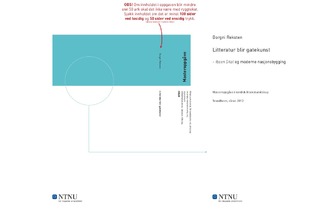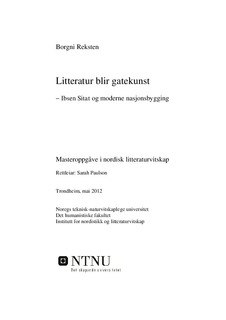| dc.contributor.advisor | Paulson, Sarah | nb_NO |
| dc.contributor.author | Reksten, Borgni | nb_NO |
| dc.date.accessioned | 2014-12-19T13:07:52Z | |
| dc.date.available | 2014-12-19T13:07:52Z | |
| dc.date.created | 2012-05-09 | nb_NO |
| dc.date.issued | 2012 | nb_NO |
| dc.identifier | 525834 | nb_NO |
| dc.identifier.uri | http://hdl.handle.net/11250/243785 | |
| dc.description.abstract | Ibsen Sitat is an artwork consisting of 69 quotations shaped in steel, placed in the pavement between Grand Café in the “Karl Johans gate” and the museum of Ibsen at “Arbins gate 1”. They are placed where Ibsen took his daily walk in the last 11 years of his life, and are selected from Henrik Ibsen’s plays, poems, letters and one speech.
Several quotations ”communicate” with the buildings around them. This may lead to a limited reading, but the buildings can also add interesting dimensions to the analysis. In the transformation from play, scripts and other text to the pavement, the quotations lose their originally context. Many transforms from lines in a play to direct enquiry to the viewer. In this way they become words of wisdom and advice for the passersby. Several quotations deal with language, poetry and reading, which create a meta-level that affects the reading of the whole piece. As an extension we can also find quotations that deal with poetry and the home. Ibsen Sitat is connected to Ibsen as a person, and the meta-level are made stronger by his signature in the pavement by the Ibsen museum.
In the 19th century, Norway needed to build the nation and mark their distance to Denmark and Sweden. This is no longer a need, but I argue that Ibsen Sitat is part of what I call modern nation building. This emphasizes the history and what is worth preserving. A piece of the past is passed on to modern people, in shape of the artwork on the street. With Ibsen Sitat placed by the Norwegian Parliament, the University of Oslo, the National theatre and the Norwegian royal castle, one underline that Ibsen was Norwegian and important for Norway. Ibsen was partly critical to the national romanticism, but is, despite of some ambiguity, used in branding of Norway and is part of modern nation building.
My problem for discussion is: When quotations by Ibsen are placed on the street, they address the reader directly. New contexts appear around the quotations, and the art piece creates a meta-level throughout comments on poetry and the homelike. Ibsen Sitat is placed in the capital’s main street, and surrounded by symbolic buildings for the nation of Norway. In this way the piece build a connection between past and future. Ibsen Sitat is included in, despite ambiguities, in what we may call modern nation building. | nb_NO |
| dc.description.abstract | Ibsen Sitat er eit kunstverk som består av 69 sitat som er forma i stål og fresa ned i granitten på fortaua mellom Grand Café på Karl Johans gate og Ibsenmuseet i Arbins gate 1. Sitata fylgjer ruta Henrik Ibsen gjekk kvar dag i dei siste 11 åra av livet, og er henta frå Ibsen sine dramastykke, dikt, brev og ein tale.
Fleire sitat spelar på omgjevnadane og "kommuniserar" med omkringliggande bygningar. Dette kan føre til ei avgrensing av lesinga, men bygningane kan òg tilføre interessante dimensjonar. På vegen frå drama og anna tekst til fortauet mistar sitata sin opphavlege kontekst. Mange går frå å vere replikkar i skodespel til å vende seg direkte til betraktaren. Slik tek dei form som råd og visdomsord til den som går forbi. Fleire sitat omhandlar språk og dikting, og det blir det skapt eit metanivå i verket som spelar inn på lesinga av heile Ibsen Sitat. Som ei forlenging av dette finn vi òg sitat som omhandlar dikting og heimen. Sitatgata blir knytt til Ibsen som person, og det metatekstlege blir ytterlegare forsterka av signaturen hans i fortauet utanfor Ibsenmuseet.
På 1800-talet hadde Noreg behov for å bygge nasjonen og skape avstand til Danmark og Sverige. Dette behovet har ein ikkje lenger, men eg meinar at Ibsen Sitat inngår i det eg kallar moderne nasjonsbygging. Denne legg vekt på historia og det bevaringsverdige. Ein bit av fortida blir overlevert til moderne menneske, i form av kunstverket på gata. Med Ibsen Sitat plassert langs Stortinget, Universitetet, Nationaltheatret og Slottet, understrekar ein at Ibsen var norsk og viktig for Noreg. Ibsen var til dels ein skarp kritikar av nasjonalromantikken, men blir, trass tvitydigheiter, brukt som ein merkevare for nasjonen Noreg og er del av moderne nasjonsbygging.
Problemformuleringa mi er: Når sitat av Ibsen blir lagt på gata, vender dei seg direkte til lesaren. Nye kontekstar oppstår rundt sitata, og kunstverket skaper eit metanivå gjennom kommentarar om dikting og det heimlege. Sitatgata ligg i hovudstaden si paradegate, omkransa av historiske og symbolske bygningar for nasjonen Noreg. Slik bygger verket bru mellom fortid og framtid. Ibsen Sitat inngår, til trass for tvitydigheiter, i det vi kan kalle moderne nasjonsbygging. | nb_NO |
| dc.language | nor | nb_NO |
| dc.publisher | Norges teknisk-naturvitenskapelige universitet, Det humanistiske fakultet, Institutt for nordistikk og litteraturvitenskap | nb_NO |
| dc.title | Litteratur blir gatekunst – Ibsen Sitat og moderne nasjonsbygging | nb_NO |
| dc.type | Master thesis | nb_NO |
| dc.source.pagenumber | 83 | nb_NO |
| dc.contributor.department | Norges teknisk-naturvitenskapelige universitet, Det humanistiske fakultet, Institutt for nordistikk og litteraturvitenskap | nb_NO |

